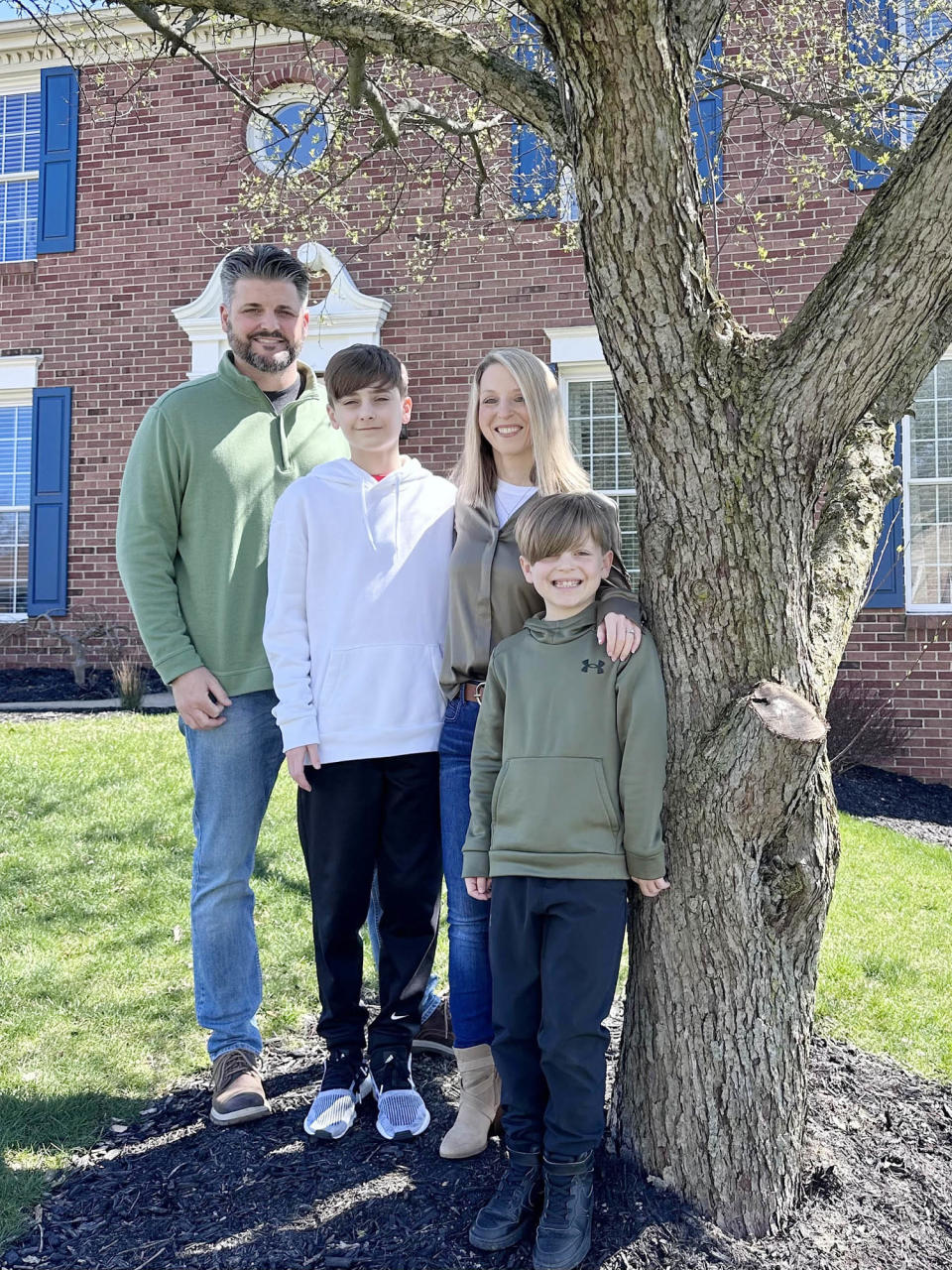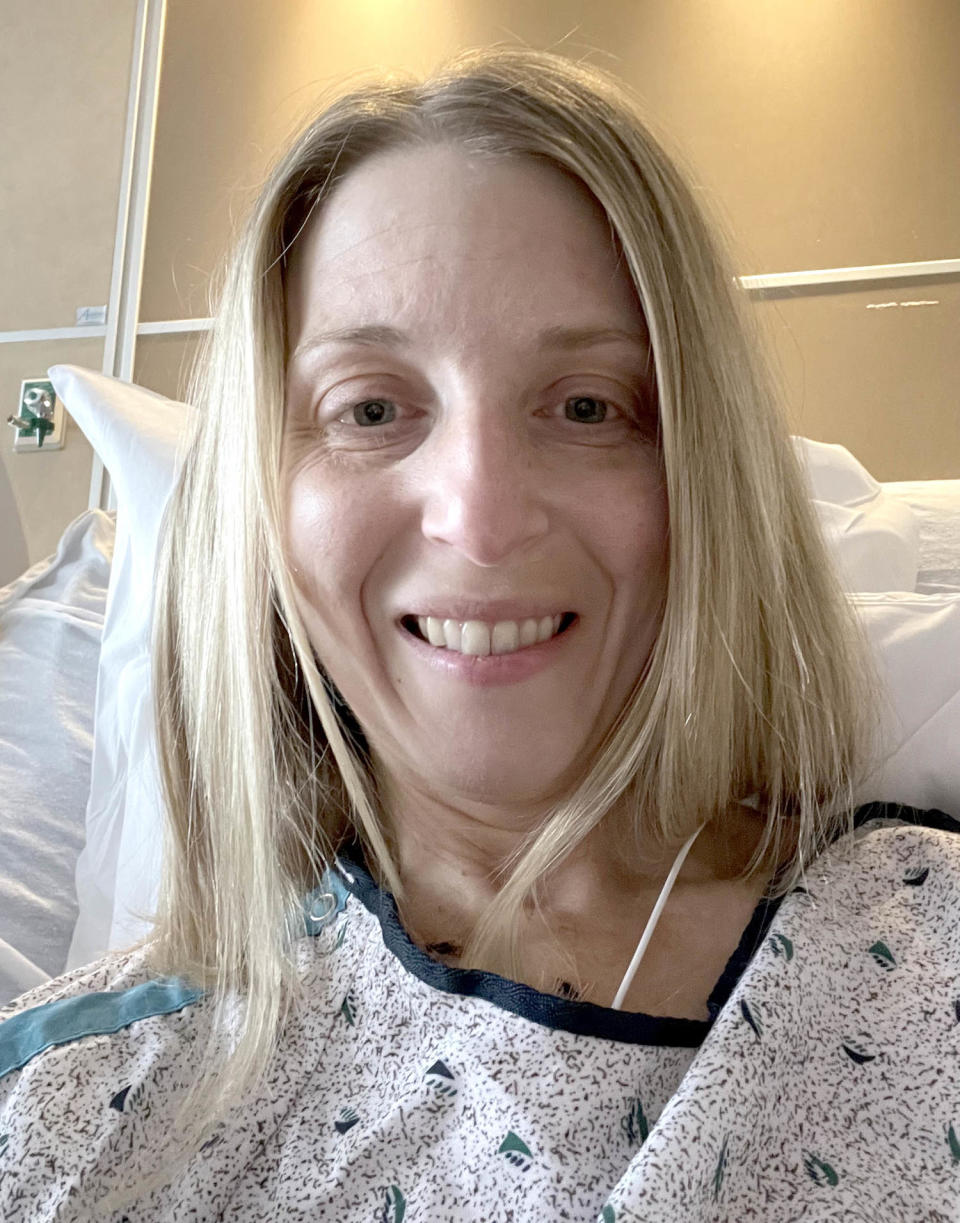After going on vacation in July 2022, Loree Benigni, then 39, returned home and felt like she had the flu. When her symptoms didn’t improve, she visited an urgent care, where doctors ran tests and saw something wrong with the electric signals in her heart. They recommended that she go to the emergency room, and there Benigni learned her condition was dire.
“They told me at that time I was one of the sickest patients in the ER,” Benigni, now 41, of Pittsburgh, tells TODAY.com. “The last thing I remember is giving them my husband’s phone number and then I blacked out.”
She lost consciousness because she experienced cardiac arrest due to viral myocarditis, inflammation in middle layer of the heart muscle caused by an infection, according to the American Heart Association. It impacts the heart’s ability to pump blood properly.
“I must have caught a virus like a cold or flu while I was on vacation,” Benigni says. “That’s what attacked my heart.”
Struggling to breath after vacation
For their 15th wedding anniversary in 2022, Benigni and her husband visited North Carolina and spent time hiking. When she returned home, she felt worried that she experienced shortness of breath when she moved.
“My whole entire life I’ve been pretty healthy,” she says. “I exercise every day. I was hiking a mountain.”

Benigni took several COVID tests, but they were all negative. She wondered if she had the flu or pneumonia, so she visited the local urgent care clinic in the middle of July. Doctors there realized how ill she was and sent her to the emergency room. Once at the hospital, things escalated quickly.
“I was completely out of breath,” she says. “(When) the nurse took my temperature, I got physically ill, and they rushed me back to a room.”
They took Benigni for a CT scan to get internal images of her body, but she was starting to lose consciousness. She experienced cardiac arrest and woke two days later, confused.
“I was rushed to another hospital,” she says. “I didn’t know where I was. … I was extremely swollen from all the things that happened to me.”
It took her a few days to feel alert and understand what occurred. She felt stunned by the news that she experienced cardiac arrest and had myocarditis, which can lead to heart failure. Doctors told her family she only had only a 5% chance of survival.
“I was numb because again I never had heart problems, and I was hearing the word ‘heart failure,’” she says. “It just happened so quickly. I was just on vacation, and now I’m in a hospital bed.”
Doctors wanted to implant a left ventricular assist device (LVAD) called the Abbott HeartMate 3 LVAD to allow her heart to rest and recover. A LVAD assists the heart by pumping blood from the left ventricle to the body. While she was hesitant to undergo open-heart surgery to place the pump, Benigni agreed to it because she wanted to return home to her children. She hoped to have it implanted right away, but she had developed pneumonia in the hospital.
“They wanted to give my body time to rest and get my strength up,” she says. “I had to learn how to walk again. I remember the first time physical therapy came in, and I tried to get up. I never thought I was going to be able to walk again or get out of that bed. I was so weak.”
She worried that she wouldn’t be able to take care of her sons.
“It was like, ‘Am I ever going to be able to go home? What happened? What did I do wrong?’” Benigni recalls. “You’re asking yourself all these questions.”
After a few weeks, by early August, she had recovered enough to have the LVAD placed.
“I was going to have to stay in the hospital for a couple more weeks,” Benigni says. “But it gave me hope that I would be able to go home.”
What is myocarditis?
“Myocarditis … means there is a problem with the heart muscle, and it makes it hard for the heart to pump blood,” Dr. Robert Kormos, divisional vice president, global medical affairs for Abbott’s heart failure business, who did not treat Benigni, tells TODAY.com. “If myocarditis isn’t detected, it is going to lead to heart failure.”


Myocarditis can also contribute to stroke or cardiac arrest, like it did in Benigni’s case. Viruses, such as flu or COVID, can cause viral myocarditis, and cardiologists saw an uptick of such cases during the pandemic, Kormos explains.
For some patients, there are early warning signs of myocarditis, but they may go unnoticed, such as palpitations or an irregular heartbeat.
According to the American Heart Association, other signs of myocarditis can include:
-
Tiredness
-
Shortness of breath
-
Fever
-
Chest pain
-
Racing heartbeat
-
Feeling faint
-
Flu-like symptoms
Doctors have several treatment options that range from medications to implanting a LVAD, all aimed that helping the heart work better while recovering from myocarditis and heart failure.
“If you give the heart muscle time to recover … you give the heart a chance to repair itself,” Kormos says. “In a period of six to eight months, (a patient) can rehabilitate themselves and their heart with proper medication and a heart pump.”
While treatment is available, Kormos notes that often women with heart problems are “poorly diagnosed.”
“A lot of physicians will say, ‘You have the flu. You are short of breath for some other reason,’” he explains. “(It’s) poorly recognized. It is a real challenge.”
In Benigni’s case, doctors quickly diagnosed her correctly.
“This young lady was very fortunate. She had immediate care, and the physician team and the heart surgery specialist made the quick decision to give her the care (she needed),” he says. “Roughly half the women in this country aren’t aware that heart disease is the No. 1 killer of women.”
He recommends that patients regularly see a doctor to understand their risks of heart disease. If they have high blood pressure or diabetes, they need to make sure it’s being properly treated to try to reduce their chance of developing complications. Kormos also believes doctors need to more attune to signs of heart disease in women and make timely diagnosis.
‘My children needed their mother’
After having her LVAD placed, Benigni spent more time in the hospital before returning home for her sons’ first day of school in the fall of 2022.
“That was like a little gift to me that I was there for their first day of school because I never missed that,” she says.


Her family, husband and neighbors helped out while she was in the hospital and after she returned home. To build up her strengt,h she began taking short walk, and returning home.To start, she got past three houses in her neighborhood but went a little bit farther every day.
“Seeing that I was able to walk again, I wasn’t out of breath … that gave me the motivation to want to do more,” she says.
Benigni kept walking, took her medications and included lots of healthy food into her diet.
At her first follow-up appointment, he ejection fraction, a measure of how well the heart pumps blood, was almost back to normal. By January 2023, Benigni was doing so well that doctors believed they could remove her pump and her heart would work well on its own.
“I cried. I was extremely happy,” she says. “I did everything I possibly could do to help myself, and I was just ecstatic.”
Recovery felt easier after her second surgery, even though it was another open heart surgery. Within days, she could walk the halls of the hospital and soon went home. Benigni has returned to work and taking care of her children, and feels incredibly grateful.
“I feel thankful every day that I can go to my son’s baseball games, and I can take my other son fishing,” she says. “I knew my children needed their mother, and I fought every day to get well again.”
Benigni wants people to seek help if something feels off in their bodies. “Go to the doctor,” she says. “Don’t wait.”
This article was originally published on TODAY.com
Source Agencies

